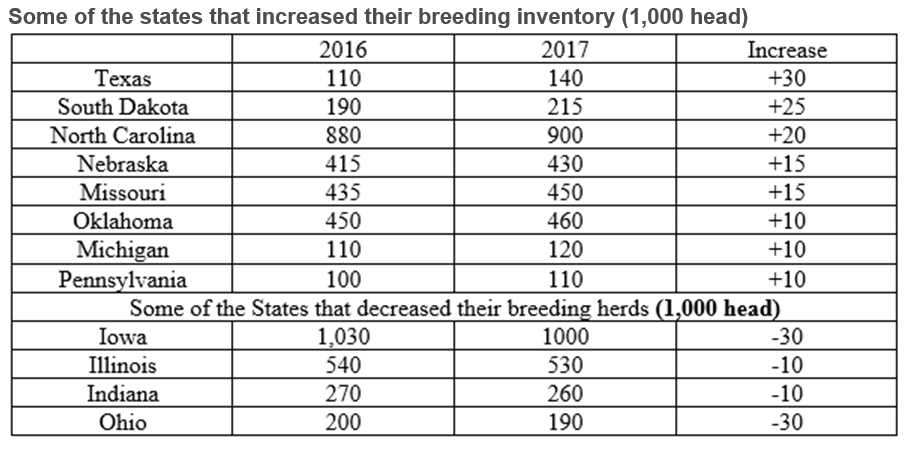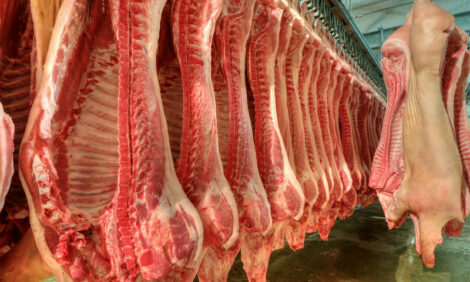



Jim Long Pork Commentary: U.S.D.A Hog and pigs report more pigs!
Last Friday the U.S.D.A released an inventory report for the U.S.The U.S market inventory continues to increase up 2% from a year ago. An increase of about 1.6 million head.If we use a time line of 26 weeks (182 days) from birth to market this would be an increase of 60,000 head per week on average. Since last December 1 three new slaughter plants have come into production. Sioux City, Coldwater, and Windon. These three plants have brought on increased capacity of at least 125,000 – 170,000 per week. Obviously there will be enough shackles going forward to handle all the hogs.
The breeding inventory has increased 69,000 from a year ago. A significant number but not as extraordinary as some pundits would have led us to believe was happening.
We expect a steady increase of sow numbers. Nothing that is huge, with the days of someone building a new 100,000 sow system is over. Too expensive, labor hard to get and environmental issues make almost everything a fight to get permitted.
As we increased hog numbers the U.S.D.A proposal to grade carcasses based on marbling and color is ever more important. Our industry continues to need to enhance pork demand to move ever and ever more pork. A grade program will lead to changing the discussion and economics from “the other White Meat” and lean, lean, lean to producing pork that consumers will have a better eating experience is a no brainer.
Last Friday was the deadline for comments to the U.S.D.A Pork Grading Changes. Below is Genesus comments that were sent to U.S.D.A . All comments will be made public by U.S.D.A.
Pork Carcass Revisions;
Standardization Branch, Quality Assessment Division, Livestock Poultry and Seed Program, AMS;
USDA 1400 Independence Ave. SW., Room 3932-S,
STOP 0258 Washington DC 20250-0258;
Email: [email protected]
December 8, 2017
To Whom It May Concern,
We are pleased to provide comments on the proposed changes to the United States Standards for Grades of Pork Carcasses. Our specific comments follow on the second page. These proposed changes provide a significant opportunity for the US pork industry to address consumer concerns with pork quality thereby driving pork demand both domestically and internationally. As well, the opportunity to provide economic signals to pork producers through the proposed quality grades are also important.
In closing, we appreciate the opportunity to comment and fully support the move towards a pork quality grade system.
Sincerely,
Robert Kemp, PhD VP Genetic Programs and R&D
cc Jim Long, President & CEO, Genesus Genetics Inc.
4501 West Homefield Drive, Sioux Falls, SD 57106
Re: Docket Number AMS-LPS-17-0046;
Federal Register Vol. 82, No. 203 Page 48971 October 23, 2017
Submission Date: December 8, 2017
United States Standards for Grades of Pork Carcasses – Comment
Genesus Genetics Inc. appreciates the opportunity for comment and congratulates the National Pork Board and the USDA Agriculture Marketing Service for their leadership in the proposed changes to the Standards for Grades of Pork Carcasses. Since the mid 1980’s, the US pork industry has focused primarily on lean yield with little to no emphasis on pork quality. This has led to reduced quality and inconsistent pork delivered to the consumer, negatively affecting the consumers eating experience and growth in pork demand, both domestically and internationally. Numerous studies and surveys reveal that today’s consumers want pork that is consistent and delivers more flavor and taste. Genesus Genetics Inc. has always believed that growing pork demand requires a strong focus on the consumer and pork quality. As an industry, we need to ensure that the consumer is guaranteed an ultimate eating experience each time they consume pork.
We are very supportive of the proposed changes to the United States Standards for Grades of Pork Carcasses. The proposed quality grade system directly reflects consumer-recognized meat quality attributes, color and marbling. We believe it is important for there to be sufficient differentiation between the various grades to ensure a recognizable and consistent consumer eating experience. If the consumer cannot consistently distinguish different eating experiences between the grades then the consumer will find the grades confusing and less useful. For example, having the Choice and Select grades at the same marbling criteria, does not seem ideal for delivering the consumer-desired consistent and superior eating experiences. The table below outlines our suggestions for the Quality grade criteria:
We also strongly urge, as an industry we work toward adapting line-speed equipment that would allow for objective color determination. We believe technology exists for objective determination of loin IMF. The more we can eliminate subjective scoring the better it will be for differentiating pork quality and enhancing the consumers eating experience.
In closing, the pork quality focus of the proposed grading changes will enhance the consumers ultimate eating experience thereby driving growth in pork demand, industry profitability and sustainability. Thank you for the opportunity to comment on these proposed changes and we look forward to their implementation.
Genesus believes that the Global Swine Industry needs to produce Pork “That leads to a great eating experience!”
“Change is inevitable, except from vending machines.” – Anonymous











